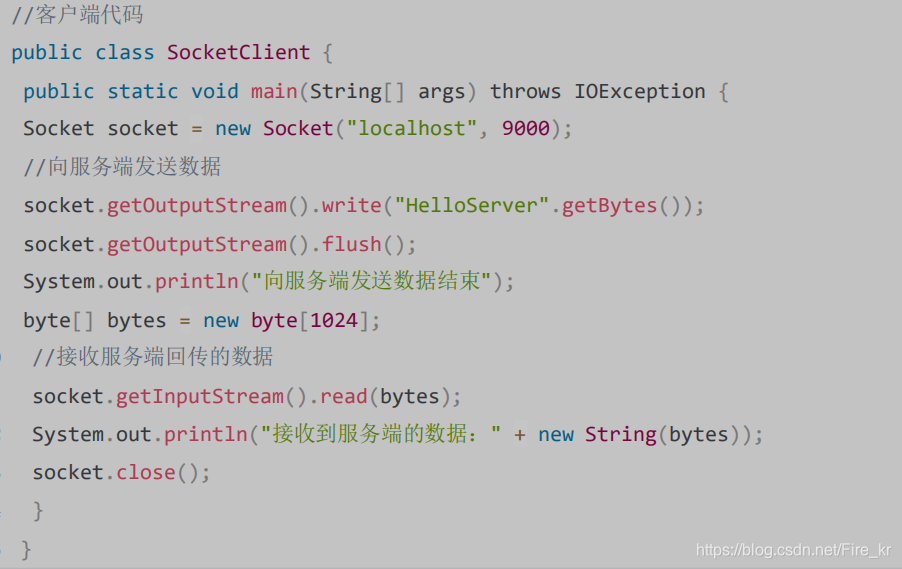java支持三种网络编程模型:
BIO
同步阻塞模型
先说服务端:里面有两个重要的方法,accept(),read(bytes)
accept(),是准备接受连接的意思,此时是阻塞的,如果客户端没有发起连接,服务端就会一直等待。
read(bytes)是读取客户端连接,如果客户端没有发送数据,服务端也会阻塞等待。
BIO模型是阻塞模型,每个客户端和服务端进行通信的时候,都会创建一个线程。
这样有两个弊端:
(1)IO代码里read操作是阻塞操作,如果连接不做数据读写操作会导致线程阻塞,浪费资源
(2)每个客户端连接都会创建一个线程,压力太大
场景:适合连接数目比较小且固定的架构,虽然对服务器要求比较高,但简单如果理解
来张图:





NIO
同步非阻塞模型
因为BIO有种种弊端,那么来看下NIO
服务端模式为一个线程可以处理多个请求,客户端发送的请求都会注册到多路利用器上selector上,selector轮询到有IO连接有进行处理
场景:适用于连接数目多,但连接时间短的架构。如果服务间通讯,聊天服务器,弹幕系统等。

NIO三大组件:
channel(通道)
selector(多路复用器)
buffer(缓冲区)

3、selector可以对应一个或多个线程
代码如下:
import java.io.IOException;
import java.net.InetSocketAddress;
import java.nio.ByteBuffer;
import java.nio.channels.SelectionKey;
import java.nio.channels.Selector;
import java.nio.channels.ServerSocketChannel;
import java.nio.channels.SocketChannel;
import java.util.Iterator;
//服务端代码
public class NIOServer {
public static void main(String[] args) throws IOException {
// 创建一个在本地端口进行监听的服务Socket通道.并设置为非阻塞方式
ServerSocketChannel ssc = ServerSocketChannel.open();
//必须配置为非阻塞才能往selector上注册,否则会报错,selector模式本身就是非阻塞模式
ssc.configureBlocking(false);
ssc.socket().bind(new InetSocketAddress(9000));
// 创建一个选择器并将serverSocketChannel注册到它上面
Selector selector = Selector.open();
// 把channel注册到selector上,并且selector对客户端accept连接操作感兴趣
ssc.register(selector, SelectionKey.OP_ACCEPT);
while (true) {
System.out.println("等待事件发生。。");
// 轮询监听key,select是阻塞的,accept()也是阻塞的
selector.select();
System.out.println("有事件发生了。。");
// 有客户端请求,被轮询监听到
Iterator<SelectionKey> it = selector.selectedKeys().iterator();
while (it.hasNext()) {
SelectionKey key = it.next();
//删除本次已处理的key,防止下次select重复处理
it.remove();
handle(key);
}
}
}
private static void handle(SelectionKey key) throws IOException {
if (key.isAcceptable()) {
System.out.println("有客户端连接事件发生了。。");
ServerSocketChannel ssc = (ServerSocketChannel) key.channel();
//此处accept方法是阻塞的,但是这里因为是发生了连接事件,所以这个方法会马上执行完
SocketChannel sc = ssc.accept();
sc.configureBlocking(false);
//通过Selector监听Channel时对读事件感兴趣
sc.register(key.selector(), SelectionKey.OP_READ);
} else if (key.isReadable()) {
System.out.println("有客户端数据可读事件发生了。。");
SocketChannel sc = (SocketChannel) key.channel();
ByteBuffer buffer = ByteBuffer.allocate(1024);
buffer.clear();
int len = sc.read(buffer);
if (len != (-1)) {
System.out.println("读取到客户端发送的数据:" + new String(buffer.array(), 0, len));
}
ByteBuffer bufferToWrite = ByteBuffer.wrap("HelloClient".getBytes());
sc.write(bufferToWrite);
key.interestOps(SelectionKey.OP_READ | SelectionKey.OP_WRITE);
sc.close();
}
}
}

package com.leyou.test;
import java.io.IOException;
import java.net.InetSocketAddress;
import java.nio.ByteBuffer;
import java.nio.channels.SelectionKey;
import java.nio.channels.Selector;
import java.nio.channels.SocketChannel;
import java.util.Iterator;
//客户端代码
public class NioClient {
//通道管理器
private Selector selector;
/**
* 启动客户端测试
*
* @throws IOException
*/
public static void main(String[] args) throws IOException {
NioClient client = new NioClient();
client.initClient("127.0.0.1", 9000);
client.connect();
}
/**
* 获得一个Socket通道,并对该通道做一些初始化的工作
*
* @param ip 连接的服务器的ip
* @param port 连接的服务器的端口号
* @throws IOException
*/
public void initClient(String ip, int port) throws IOException {
// 获得一个Socket通道
SocketChannel channel = SocketChannel.open();
// 设置通道为非阻塞
channel.configureBlocking(false);
// 获得一个通道管理器
this.selector = Selector.open();
// 客户端连接服务器,其实方法执行并没有实现连接,需要在listen()方法中调
//用channel.finishConnect();才能完成连接
channel.connect(new InetSocketAddress(ip, port));
//将通道管理器和该通道绑定,并为该通道注册SelectionKey.OP_CONNECT事件。
channel.register(selector, SelectionKey.OP_CONNECT);
}
/**
* 采用轮询的方式监听selector上是否有需要处理的事件,如果有,则进行处理
*
* @throws IOException
*/
public void connect() throws IOException {
// 轮询访问selector
while (true) {
// 选择一组可以进行I/O操作的事件,放在selector中,客户端的该方法不会阻塞,
//这里和服务端的方法不一样,查看api注释可以知道,当至少一个通道被选中时,
//selector的wakeup方法被调用,方法返回,而对于客户端来说,通道一直是被选中的
selector.select();
// 获得selector中选中的项的迭代器
Iterator<SelectionKey> it = this.selector.selectedKeys().iterator();
while (it.hasNext()) {
SelectionKey key = (SelectionKey) it.next();
// 删除已选的key,以防重复处理
it.remove();
// 连接事件发生
if (key.isConnectable()) {
SocketChannel channel = (SocketChannel) key.channel();
// 如果正在连接,则完成连接
if (channel.isConnectionPending()) {
channel.finishConnect();
}
// 设置成非阻塞
channel.configureBlocking(false);
//在这里可以给服务端发送信息哦
ByteBuffer buffer = ByteBuffer.wrap("HelloServer".getBytes());
channel.write(buffer);
//在和服务端连接成功之后,为了可以接收到服务端的信息,需要给通道设置读的权限。
channel.register(this.selector, SelectionKey.OP_READ); // 获得了可读的事件
} else if (key.isReadable()) {
read(key);
}
}
}
}
/**
* 处理读取服务端发来的信息 的事件
*
* @param key
* @throws IOException
*/
public void read(SelectionKey key) throws IOException {
//和服务端的read方法一样
// 服务器可读取消息:得到事件发生的Socket通道
SocketChannel channel = (SocketChannel) key.channel();
// 创建读取的缓冲区
ByteBuffer buffer = ByteBuffer.allocate(512);
int len = channel.read(buffer);
if (len !=(-1) ) {
System.out.println("客户端收到信息:" + new String(buffer.array(), 0, len));
}
}
}
AIO
异步非阻塞模型(底层是NIO)
import java.io.IOException;
import java.net.InetSocketAddress;
import java.nio.ByteBuffer;
import java.nio.channels.AsynchronousServerSocketChannel;
import java.nio.channels.AsynchronousSocketChannel;
import java.nio.channels.CompletionHandler;
/*服务端代码*/
public class AIOServer {
public static void main(String[] args) throws Exception {
final AsynchronousServerSocketChannel serverChannel =
AsynchronousServerSocketChannel.open().bind(new InetSocketAddress(9000));
serverChannel.accept(null, new CompletionHandler<AsynchronousSocketChannel, Object>() {
@Override
public void completed(AsynchronousSocketChannel socketChannel, Object attachment) {
try {
// 再此接收客户端连接,如果不写这行代码后面的客户端连接连不上服务端
serverChannel.accept(attachment, this);
System.out.println(socketChannel.getRemoteAddress());
ByteBuffer buffer = ByteBuffer.allocate(1024);
socketChannel.read(buffer, buffer, new CompletionHandler<Integer, ByteBuffer>() {
@Override
public void completed(Integer result, ByteBuffer buffer) {
buffer.flip();
System.out.println(new String(buffer.array(), 0, result));
socketChannel.write(ByteBuffer.wrap("HelloClient".getBytes()));
}
@Override
public void failed(Throwable exc, ByteBuffer buffer) {
exc.printStackTrace();
}
});
} catch (IOException e) {
e.printStackTrace();
}
}
@Override
public void failed(Throwable exc, Object attachment) {
exc.printStackTrace();
}
});
Thread.sleep(Integer.MAX_VALUE);
}
}
客户端代码:
import java.net.InetSocketAddress;
import java.nio.ByteBuffer;
import java.nio.channels.AsynchronousSocketChannel;
public class AIOClient {
public static void main(String... args) throws Exception {
AsynchronousSocketChannel socketChannel = AsynchronousSocketChannel.open();
socketChannel.connect(new InetSocketAddress("127.0.0.1", 9000)).get();
socketChannel.write(ByteBuffer.wrap("HelloServer".getBytes()));
ByteBuffer buffer = ByteBuffer.allocate(512);
Integer len = socketChannel.read(buffer).get();
if (len != (-1)) {
System.out.println("客户端收到信息:" + new String(buffer.array(), 0, len));
}
}
}
最后来张图:
























 424
424











 被折叠的 条评论
为什么被折叠?
被折叠的 条评论
为什么被折叠?








